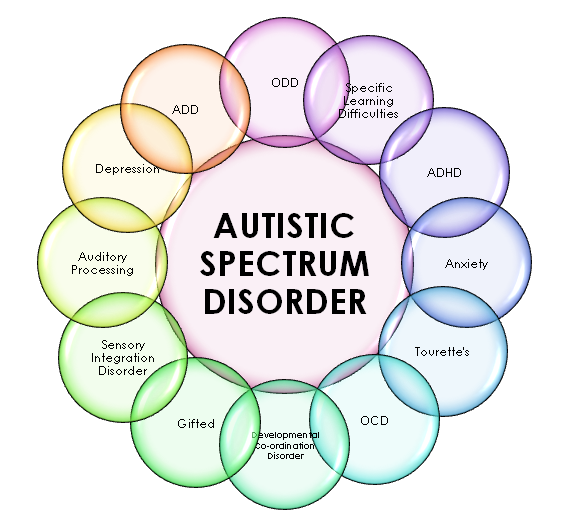Ingenious Therapies and Therapies: Advancements in Autism Study
Ingenious Therapies and Therapies: Advancements in Autism Study
Blog Article
Discovering Autism: Approaches for Reliable Interaction and Communication
Effective interaction and interaction with individuals on the autism range require an extensive understanding of their unique demands and preferences. The intricacies of these approaches disclose further factors to consider that merit expedition, particularly in exactly how they can be adapted to private experiences and diverse contexts.
Comprehending Autism Range Disorder
Autism Range Disorder (ASD) includes a series of neurodevelopmental conditions identified by challenges in social communication, interaction, and repetitive actions. The term "spectrum" shows the varied manifestations and varying levels of extent experienced by individuals with ASD. While some might exhibit considerable problems, others might display high-functioning characteristics, permitting higher freedom in day-to-day live.
The onset of ASD normally takes place in early youth, with indicators frequently identifiable by age 2. Early indicators may include postponed speech advancement, restricted eye get in touch with, and troubles in recognizing social cues. Although the accurate etiology of ASD continues to be unclear, research study suggests a combination of ecological and hereditary variables plays an important function in its advancement.
People with ASD commonly have special staminas, such as increased interest to detail and outstanding memory abilities. They might battle with comprehending abstract ideas and managing adjustments to regular - autism. Therefore, treatments and support tailored to specific requirements are vital for fostering interaction and social abilities. Identifying the complexity of ASD is crucial for promoting understanding, approval, and effective methods that help with purposeful interactions with individuals on the spectrum.

Relevance of Clear Interaction
Effective interaction is vital for promoting understanding and link, particularly for individuals with Autism Spectrum Problem (ASD) Clear communication not only assists in social interactions however also improves the person's ability to reveal their needs, feelings, and thoughts. For people with ASD, the subtleties of language can usually be testing; consequently, making use of unambiguous and simple language is crucial.
Furthermore, clear interaction helps reduce frustration and anxiety that may arise from misconceptions. When messages are shared in a straight and regular way, individuals with ASD are better equipped to analyze information accurately, which can substantially enhance their social interaction and involvement in numerous settings.
Developing regimens and utilizing visual assistances can additionally boost clear communication. These strategies offer individuals with foreseeable structures that assist comprehension and retention of details. Additionally, proactively being and paying attention client throughout communications promotes a helpful atmosphere where individuals with ASD feel valued and understood.
Eventually, prioritizing clear communication not just equips individuals with ASD but also promotes even more significant links with their peers, caretakers, and the bigger area, leading the means for collective connections and inclusive interactions. - autism
Non-Verbal Interaction Strategies
Interaction extends beyond words, and for individuals with Autism Spectrum Disorder (ASD), non-verbal cues play a considerable function in communications. Non-verbal interaction strategies can include faces, motions, body movement, and eye call, all of which serve as crucial elements for communicating objectives and emotions.
Comprehending and translating these non-verbal signals can improve interactions with individuals with ASD. A warm smile or open posture can create an inviting environment, motivating engagement. Likewise, utilizing visual help-- such as image cards or signs-- can bridge interaction gaps and help share messages a lot more properly.
It is also vital to be conscious of personal space, as people with ASD may have various comfort degrees regarding closeness. review Observing their reactions to physical distance can educate proper modifications.

Producing Supportive Environments
Developing a helpful environment is crucial for cultivating positive interactions and improving the well-being of individuals with Autism Spectrum Condition (ASD) Such settings can considerably decrease stress and anxiety and create a feeling of safety and security, enabling individuals to express themselves much more freely.
To attain this, it is necessary to think about sensory level of sensitivities that individuals with ASD may experience. Customizing the physical space to include soft lights, minimal history noise, and comfy seating can create a relaxing ambience. In addition, using consistent regimens and clear visual schedules can aid people prepare for changes and minimize uncertainty, more advertising comfort.
Social spaces should be structured to lessen frustrating stimuli while giving opportunities for interaction in recommended activities. Assisting in areas assigned for silent time can additionally serve as a sanctuary throughout minutes of anxiety. Significantly, including elements of option equips people, permitting them to exercise original site agency in their atmosphere.

Motivating Social Communications
Promoting social communications among people with Autism Spectrum Condition (ASD) calls for deliberate approaches that prioritize convenience and engagement. Establishing foreseeable routines can assist reduce anxiety, making social setups more approachable. Producing organized environments with specified duties and functions allows individuals to involve without the frustrating pressure of unstructured social characteristics.
Including interests and staminas into social tasks can function as a driver for communication. Arranging team tasks around shared hobbies or topics of fascination can help with all-natural discussions and links. In addition, utilizing aesthetic assistances, such as photographic timetables or social manuscripts, can assist in understanding social cues and expectations.
Modeling suitable social habits is essential - autism. Peers and adults must demonstrate efficient communication methods, including active listening and turn-taking. Role-playing situations can likewise supply a secure area for people to practice these skills
Lastly, fostering peer relationships via comprehensive practices is essential. Urging comprehensive playdates or team trips can create opportunities for socializing in a comfy setup. By carrying out these strategies, educators and caretakers can substantially enhance social communications for individuals with ASD, advertising their general social advancement and well-being.
Final Thought
To conclude, efficient interaction and interaction methods are important for sustaining individuals with Autism Range Disorder. Highlighting clear language, incorporating non-verbal hints, and developing predictable regimens significantly improve involvement and decrease anxiousness. Creating helpful settings fosters safe social communications, while encouraging shared rate of interests promotes meaningful connections. Inevitably, these strategies equip people with autism to navigate social landscapes, advertising their total well-being and allowing the advancement of long-term relationships.
Reliable interaction and interaction with individuals on the autism range demand a detailed understanding of their unique requirements and preferences. Clear communication not only assists in social communications however additionally enhances the individual's capacity to express their requirements, thoughts, and emotions.Cultivating social communications among people with Autism Range Disorder (ASD) requires deliberate approaches that focus on comfort and engagement. By carrying out these caretakers, teachers and methods can significantly enhance social communications for discover here individuals with ASD, advertising their general social development and health.
In final thought, effective interaction and interaction strategies are essential for sustaining individuals with Autism Range Disorder.
Report this page